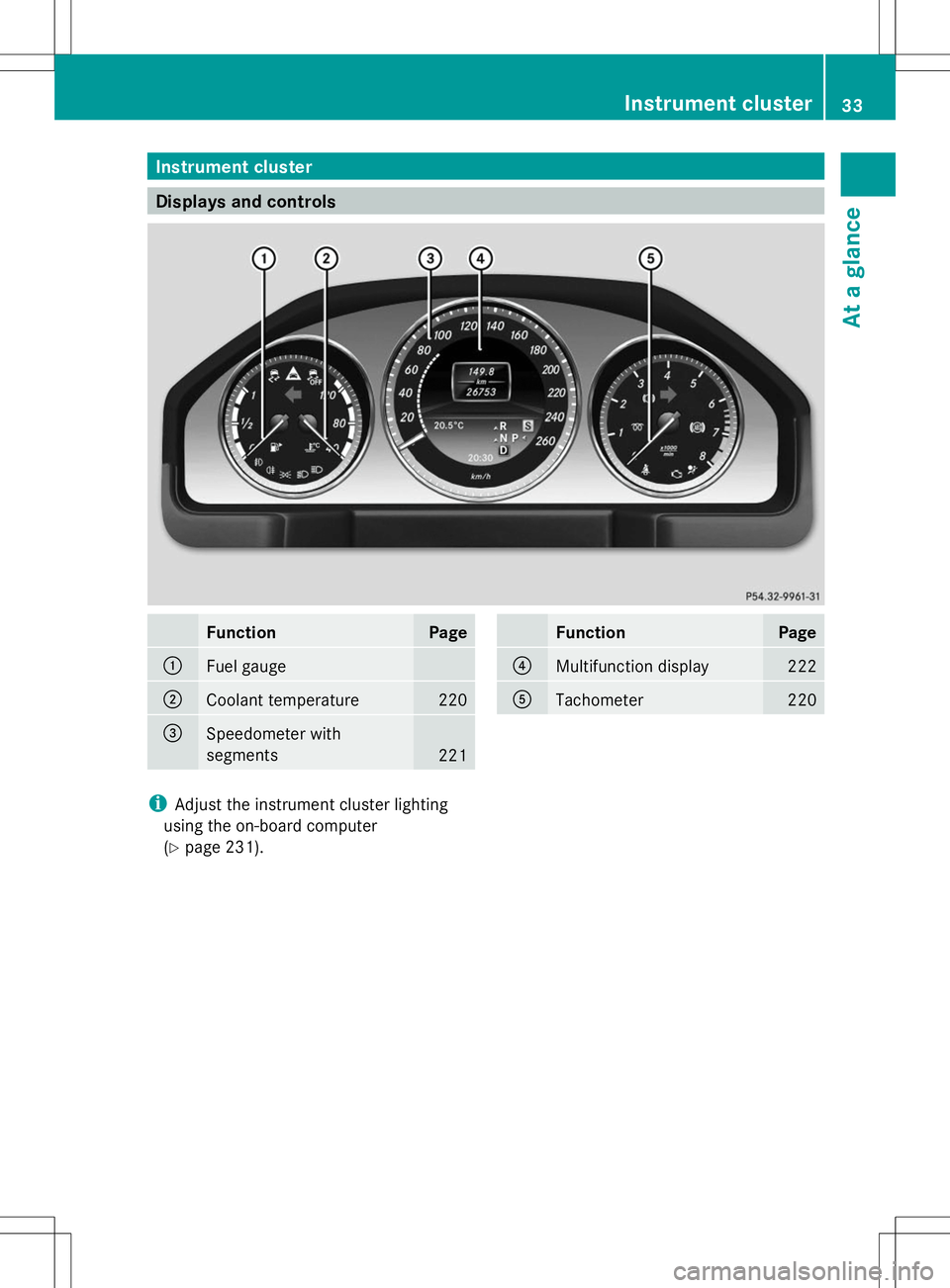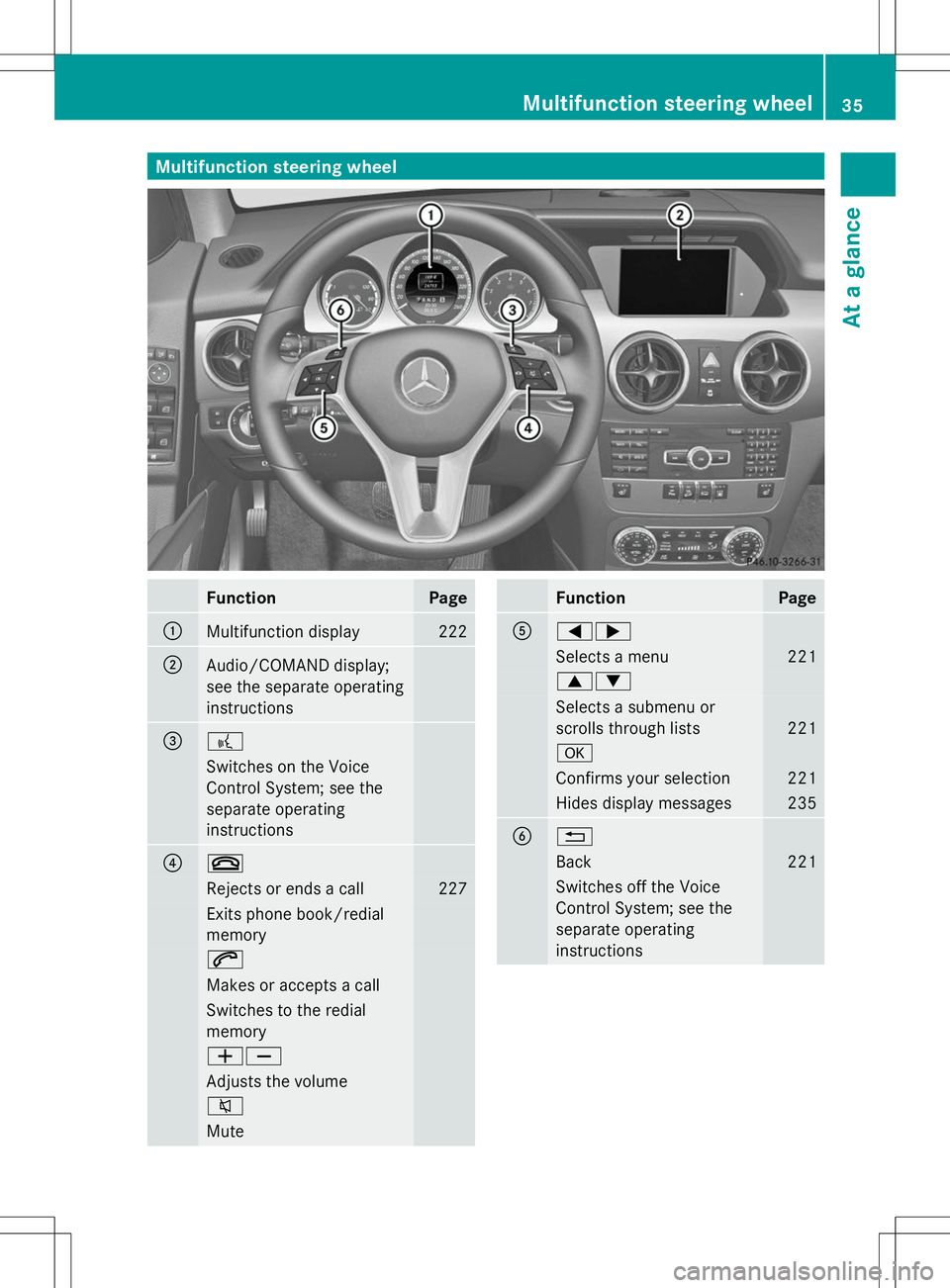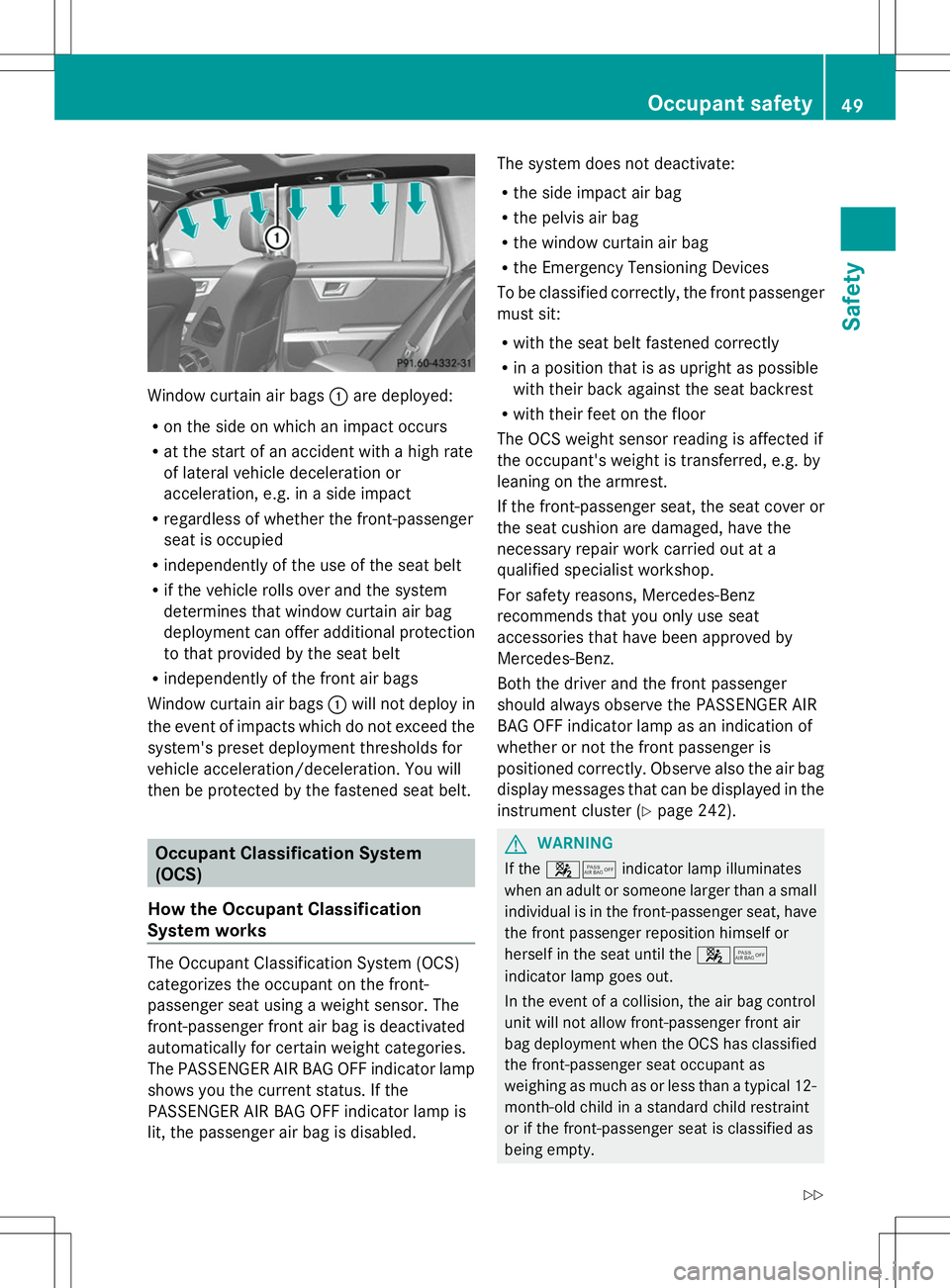2014 MERCEDES-BENZ GLK-CLASS SUV display
[x] Cancel search: displayPage 21 of 384

Tire bead (definition
)...................... 353
Tire pressure (definition) ................353
Tire pressures (recommended )...... 351
Tire size (data) ............................... 359
Tire size designation, load-bearing
capacity, speed rating .................... 348
Tire tread ....................................... 331
Tire tread (definition) .....................353
Total load limit (definition) .............354
Traction ......................................... 346
Traction (definition) .......................353
Tread wea r..................................... 346
TWR (permissible trailer drawbar
noseweight) (definition) .................353
Uniform Tire Quality Grading
Standards ...................................... 346
Uniform Tire Quality Grading
Standards (definition) ....................351
Unladen weight (definition) ............352
Wear indicator (definition) .............354
Wheel rim (definition) ....................351
see Flat tire
Top Tether ............................................ 65
Towing Important safety guidelines ...........322
Installing the towing eye ................323
Removing the towing eye ...............323
With the rear axle raised ................324
Towing a trailer
Active Parking Assist .....................192
Cleaning the trailer tow hitch ......... 310
Coupling up a trailer ......................214
Decoupling a trailer .......................216
Driving tips .................................... 212
Important safety notes ..................212
Installing the ball coupling .............214
Lights display message ..................243
Mounting dimensions ....................376
Power supply ................................. 217
Removing the ball coupling ............216
Storing the ball coupling ................217
Trailer loads ................................... 376
Towing away
With both axles on the ground .......324
Tow-starting
Emergency engine starting ............325
Important safety notes ..................322Trailer coupling
see Towing a trailer
Trailer loads and drawbar
noseweights ...................................... 216
Trailer towing Active Blind Spot Assist .................209
Active Lane Keeping Assist .... 206, 212
Blind Spot Assist ............................ 204
PARKTRONIC ................................. 187
Permissible trailer loads and
drawbar noseweights .....................216
Transfer case ..................................... 158
Transmission see Automatic transmission
Transmission position display .........153
Transmission position display
(DIRECT SELECT lever) ......................153
Transporting the vehicle ..................324
Traveling uphill Brow of hill ..................................... 173
Driving downhill ............................. 173
Maximum gradient-climbing
capability ....................................... 173
Trim pieces (cleaning instructions) .311
Trip computer (on-board computer) 223
Trip odometer Calling up ....................................... 223
Resetting (on-board computer) ......224
Turn signals
Changing bulbs (front) ...................121
Display message ............................ 244
Switching on/off ........................... 114
TWR (Tongue Weight Rating)
(definition) ......................................... 353
Type identification plate see Vehicle identification plate U
Unlocking Emergency unlocking .......................83
From inside the vehicle (central
unlocking button) ............................. 82 Index
19
Page 22 of 384

V
Vanity mirror (in the sun visor) ........ 283
Vehicle Correct use ...................................... 27
Data acquisition ............................... 28
Display message ............................ 258
Emergency locking ........................... 83
Emergency unlocking .......................83
Equipment ....................................... 23
Individual settings ..........................230
Limited Warranty ............................. 28
Loading .......................................... 342
Locking (in an emergency) ...............83
Locking (SmartKey) .......................... 76
Lowering ........................................ 358
Maintenance .................................... 24
Parking for a long period ................ 165
Pulling away ................................... 147
Raising ........................................... 356
Reporting problems .........................27
Securing from rolling away ............355
Towing away .................................. 322
Transporting .................................. 324
Unlocking (in an emergency) ...........83
Unlocking (SmartKey) ......................76
Vehicle data ................................... 375
Vehicle data ....................................... 375
Vehicle data (off-road driving) Approach/departure angl e............ 376
Fording depth ................................ 375
Maximum gradient climbing ability 376
Vehicle dimensions ...........................375
Vehicle emergency locking ................83
Vehicle identification number see VIN
Vehicle identification plate ..............366
Vehicle tool kit .................................. 314
Video (DVD) ........................................ 227
VIN ...................................................... 366W
Warning and indicator lamps ABS ................................................ 263
Brakes ........................................... 263
Check Engine ................................. 268
Coolant .......................................... 269Distance warning
........................... 271
DISTRONIC PLUS ........................... 271
ESP ®
.............................................. 265
ESP ®
OFF ....................................... 266
Fuel tank ........................................ 268
Overview .......................................... 34
PASSENGER AIRBAG OFF ................49
Reserve fuel ................................... 268
Seat belt ........................................ 261
SRS ................................................ 267
Tire pressure monitor ....................272
Warranty ............................................ 366
Washer fluid Display message ............................ 259
Wheel bolt tightening torque ...........358
Wheel chock ...................................... 355
Wheels Changing a wheel .......................... 354
Checking ........................................ 331
Cleaning ......................................... 307
Cleaning (warning) .........................355
Emergency spare wheel .................361
Important safety notes ..................330
Interchanging/changing ................354
Mounting a new wheel ...................357
Mounting a wheel .......................... 355
Removing a wheel ..........................357
Storing ........................................... 355
Tightening torque ........................... 358
Wheel size/tire size .......................359
Window curtain air bag
Display message ............................ 240
Operation ........................................ .48
Windows
see Side windows
Windshield
Defrosting ...................................... 137
Windshield washer fluid
see Windshield washer system
Windshield washer system ..............305
Notes ............................................. 373
Windshield wipers
Problem (malfunction) ...................126
Rear window wiper ........................123
Replacing the wiper blades ............123
Switching on/off ........................... 12220
Index
Page 34 of 384

Dashboard
Function Page
:
Steering wheel paddle
shifters
156
;
Combination switch 114
=
Instrument cluster 33
?
Horn
A
PARKTRONIC warning
display
185
B
Overhead control panel 38
C
Operating the climate
control systems
128
D
Ignition lock 145
Start/Stop button
145 Function Page
E
Adjusting the steering
wheel manually
104
F
Adjusting the steering
wheel electrically
104
G
Cruise control lever 174
H
Parking brake 165
I
Diagnostics connection 26
J
Opening the hood 302
K
Releasing the parking brake 165
L
Light switch 11232
Dashboa
rdAt a glance
Page 35 of 384

Instrument cluster
Displays and controls
Function Page
:
Fuel gauge
;
Coolant temperature 220
=
Speedometer with
segments
221 Function Page
?
Multifunction display 222
A
Tachometer 220
i
Adjust the instrument cluster lighting
using the on-board computer
(Y page 231). Instrument cluster
33At a glance
Page 37 of 384

Multifunction steering wheel
Function Page
:
Multifunction display 222
;
Audio/COMAND display;
see the separate operating
instructions =
?
Switches on the Voice
Control System; see the
separate operating
instructions ?
~
Rejects or ends a call 227
Exits phone book/redial
memory
6
Makes or accepts a call
Switches to the redial
memory
WX
Adjusts the volume
8
Mute Function Page
A
=;
Selects a menu 221
9:
Selects a submenu or
scrolls through lists
221
a
Confirms your selection 221
Hides display messages 235
B
%
Back 221
Switches off the Voice
Control System; see the
separate operating
instructionsMultifunction steering wheel
35At a glance
Page 51 of 384

Window curtain air bags
:are deployed:
R on the side on which an impact occurs
R at the start of an accident with a high rate
of lateral vehicle deceleration or
acceleration, e.g. in a side impact
R regardless of whether the front-passenger
seat is occupied
R independently of the use of the seat belt
R if the vehicle rolls over and the system
determines that window curtain air bag
deployment can offer additional protection
to that provided by the seat belt
R independently of the front air bags
Window curtain air bags :will not deploy in
the event of impacts which do not exceed the
system's preset deployment thresholds for
vehicle acceleration/deceleration. You will
then be protected by the fastened seat belt. Occupant Classification System
(OCS)
How the Occupant Classification
System works The Occupant Classification System (OCS)
categorizes the occupant on the front-
passenger seat using a weight sensor. The
front-passenger front air bag is deactivated
automatically for certain weight categories.
The PASSENGER AIR BAG OFF indicator lamp
shows you the current status. If the
PASSENGER AIR BAG OFF indicator lamp is
lit, the passenger air bag is disabled. The system does not deactivate:
R
the side impact air bag
R the pelvis air bag
R the window curtain air bag
R the Emergency Tensioning Devices
To be classified correctly, the front passenger
must sit:
R with the seat belt fastened correctly
R in a position that is as upright as possible
with their back against the seat backrest
R with their feet on the floor
The OCS weight sensor reading is affected if
the occupant's weight is transferred, e.g. by
leaning on the armrest.
If the front-passenger seat, the seat cover or
the seat cushion are damaged, have the
necessary repair work carried out at a
qualified specialist workshop.
For safety reasons, Mercedes-Benz
recommends that you only use seat
accessories that have been approved by
Mercedes-Benz.
Both the driver and the front passenger
should always observe the PASSENGER AIR
BAG OFF indicator lamp as an indication of
whether or not the front passenger is
positioned correctly. Observe also the air bag
display messages that can be displayed in the
instrument cluster (Y page 242). G
WARNING
If the 45 indicator lamp illuminates
when an adult or someone larger than a small
individual is in the front-passenger seat, have
the front passenger reposition himself or
herself in the seat until the 45
indicator lamp goes out.
In the event of a collision, the air bag control
unit will not allow front-passenger front air
bag deployment when the OCS has classified
the front-passenger seat occupant as
weighing as much as or less than a typical 12-
month-old child in a standard child restraint
or if the front-passenger seat is classified as
being empty. Occupant safety
49Safety
Z
Page 55 of 384

Problems with the Occupant Classification System
Problem Possible causes/consequences and
M
MSolutions The PASSENGER AIR
BAG OFF indicator
lights up and remains
on.
The person on the
front-passenger seat:
R
has the weight of a
typical adult
R has been determined
by the system not to
be a child The OCS is malfunctioning.
X
Make sure that the front passenger is sitting in a correct, upright
position.
X Have the OCS checked as soon as possible at a qualified
specialist workshop.
X Observe the additional display messages in the multifunction
display (Y page 242). G
WARNING
If the 45 indicator lamp illuminates and remains illuminated when the weight of a typical
adult or someone larger than a small individual has been detected on the passenger seat, do not
allow any occupant to use the passenger seat until the system has been repaired. Problem Possible causes/consequences and
M MSolutions The PASSENGER AIR
BAG OFF indicator
lamp does not light up
and/or stays on.
The front-passenger
seat is:
R
unoccupied
R occupied with a
weight up to that of a
typical twelve-
month-old child in a
standard child
restraint system The OCS is malfunctioning.
X
Make sure there is nothing between the seat cushion and the
child seat.
X Make sure that the backrest and base of the child restraint
system are resting securely on the front-passenger seat. If
necessary, adjust the position of the front-passenger seat.
X When installing the child restraint system, make sure that the
seat belt is tight. Do not pull the seat belt tight with the front-
passenger seat adjustment. This could result in the seat belt
being pulled too tightly.
X Check the installation of the child restraint system.
X Make sure that no objects are applying additional weight onto
the seat.
X If the PASSENGER AIR BAG OFF indicator lamp remains off, have
the OCS system checked as soon as possible at a qualified
specialist workshop. Do not transport a child on the front-
passenger seat until the OCS has been repaired.
X Observe the additional display messages in the multifunction
display (Y page 242). Occupant safety
53Safety Z
Page 70 of 384

on the ABS warning lamp (Y
page 263) and
display messages which may be shown in the
instrument cluster (Y page 236).
ABS works from a speed of about 5 mph
(8 km/h), regardless of road-surface
conditions. ABS works on slippery surfaces,
even if you only brake gently.
Braking X
If ABS intervenes: continue to depress the
brake pedal vigorously until the braking
situation is over.
X To make a full brake application:
depress the brake pedal with full force.
If ABS intervenes when braking, you will feel
a pulsing in the brake pedal.
The pulsating brake pedal can be an
indication of hazardous road conditions, and
functions as a reminder to take extra care
while driving. BAS (Brake Assist System)
General information BAS operates in emergency braking
situations. If you depress the brake pedal
quickly, BAS automatically boosts the braking
force, thus shortening the stopping distance.
Important safety notes i
Observe the "Important safety notes"
section (Y page 67). G
WARNING
If BAS is malfunctioning, the braking distance
in an emergency braking situation is
increased. There is a risk of an accident.
In an emergency braking situation, depress
the brake pedal with full force. ABS prevents
the wheels from locking. Braking X
Keep the brake pedal firmly depressed until
the emergency braking situation is over.
ABS prevents the wheels from locking.
The brakes will function as usual once you
release the brake pedal. BAS is deactivated. BAS PLUS (Brake Assist System
PLUS)
General information i
Observe the "Important safety notes"
section (Y page 67).
BAS PLUS is only available in vehicles
equipped with DISTRONIC PLUS.
For BAS PLUS to assist you, the radar sensor
system must be operational.
With the help of the radar sensor system, BAS
PLUS can detect obstacles that are in the
path of your vehicle for an extended period of
time.
If the radar sensor system is malfunctioning,
BAS PLUS will not be available. The brake
system is still available with complete brake
boosting effect and BAS.
BAS PLUS can help you to minimize the risk
of a collision with a vehicle or reduce the
effects of such a collision. If BAS PLUS
detects a danger of collision, you are assisted
when braking.
Important safety notes G
WARNING
BAS PLUS cannot always clearly identify
objects and complex traffic situations.
In such cases, BAS PLUS may:
R intervene unnecessarily
R not intervene
There is a risk of an accident.
Always pay careful attention to the traffic
situation and be ready to brake. Terminate the
intervention in a non-critical driving situation. 68
Driving safety systemsSafety